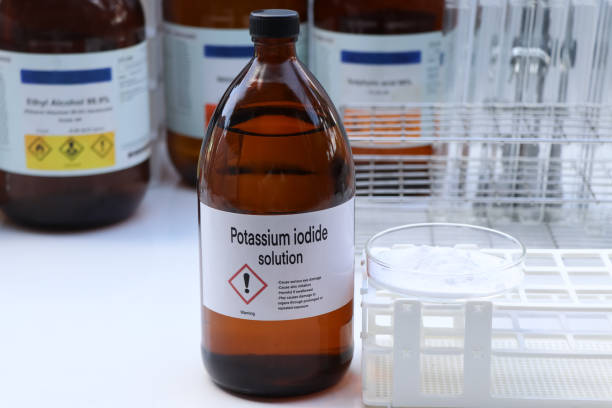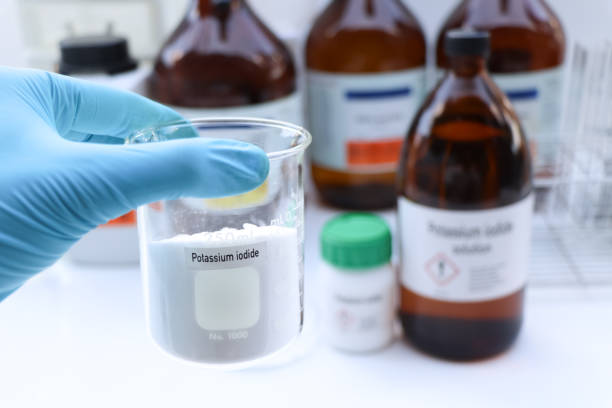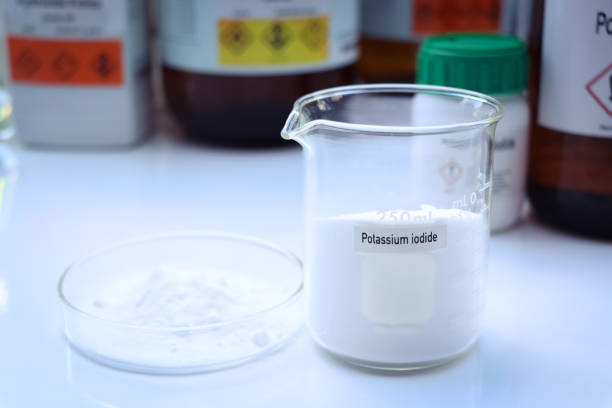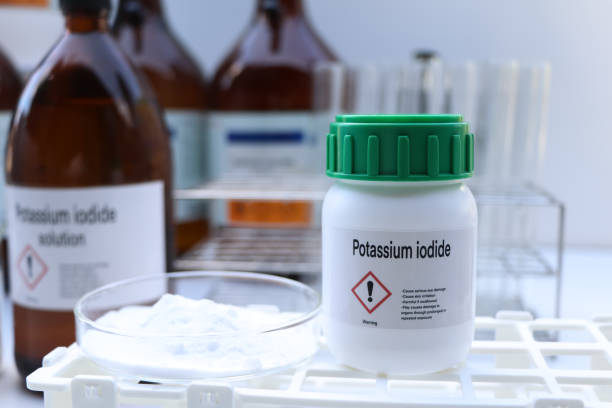A saturated solution of potassium iodide (KI) plays an essential role in chemistry, medicine, industry, and laboratory research. Understanding its properties, preparation, applications, and safety measures is crucial for students, researchers, and professionals who work with this important chemical compound.
In this complete guide, we will cover every detail about saturated potassium iodide solution, including its chemical characteristics, laboratory preparation, solubility behavior, medical uses, and industrial applications.
Introduction to Saturated Solution of Potassium Iodide.
A saturated solution is defined as a solution in which the solvent (water) has dissolved the maximum amount of solute (potassium iodide) at a given temperature. Once saturation is reached, no more solute can dissolve, and any additional KI remains undissolved at the bottom.
Potassium iodide, with the formula KI, is a white crystalline ionic compound composed of potassium (K⁺) and iodide (I⁻) ions. When dissolved in water, it dissociates completely, forming a highly conductive electrolyte solution.
Chemical Properties of Potassium Iodide
- Chemical Formula: KI
- Molar Mass: 166.00 g/mol
- Appearance: White crystalline solid
- Solubility in Water: 140–150 g per 100 mL at 25°C (very high solubility)
- Melting Point: 681°C
- Boiling Point: 1330°C
- Nature: Strong electrolyte, neutral salt
Because of its high solubility, potassium iodide readily forms saturated solutions at room temperature.
Preparation of a Saturated Solution of Potassium Iodide

To prepare a saturated solution in the laboratory or industrial settings, follow these steps:
- Take purified distilled water in a clean beaker or flask.
- Gradually add potassium iodide crystals to the water while stirring.
- Continue adding KI until no more dissolves, and undissolved crystals remain at the bottom.
- Filter the solution if necessary to remove undissolved particles.
- Store the prepared saturated solution in a tightly sealed amber bottle to prevent light-induced decomposition.
The concentration of the saturated solution will depend on the temperature of the solvent; higher temperatures allow more KI to dissolve, while lower temperatures reduce solubility.
Solubility and Temperature Dependence
The solubility of potassium iodide increases significantly with temperature. At 20°C, about 140 g dissolves in 100 mL of water, but at higher temperatures, solubility further increases. This property is useful when preparing concentrated KI solutions in the lab.
A saturated solution at room temperature is highly concentrated and remains stable under normal laboratory conditions. However, exposure to air and light can lead to oxidation of iodide ions into iodine, giving the solution a yellowish or brownish tint.
Uses of Saturated Potassium Iodide Solution in Medicine
The saturated solution of potassium iodide (SSKI) is widely used in medical treatments. Its therapeutic applications include:
- Thyroid Disorders
- Used in the treatment of hyperthyroidism to block the release of thyroid hormones.
- Administered before thyroid surgery to reduce the vascularity of the gland.
- Used as a protective measure in nuclear emergencies by blocking radioactive iodine uptake.
- Expectorant in Respiratory Illness
- It functions as a mucolytic agent, helping to thin mucus and alleviate coughing in conditions such as chronic bronchitis and asthma.
- Antifungal Properties
- Applied in the treatment of sporotrichosis, a fungal infection affecting skin and lymph nodes.
- Anti-inflammatory Action
- Sometimes used in cases of erythema nodosum and other inflammatory skin conditions.
Industrial and Laboratory Applications

Beyond medicine, saturated potassium iodide solutions have multiple industrial and scientific uses:
- Analytical Chemistry: Used in iodometric titrations to determine oxidizing agents.
- Photography: Acts as a component in photographic emulsions.
- Food Industry: Employed as a source of iodine to prevent goiter.
- Catalyst in Reactions: Plays a role in various organic and inorganic syntheses.
- Disinfectant Solutions: Forms iodine-based disinfectants when mixed with elemental iodine.
Advantages of Using Saturated KI Solution
- High solubility allows concentrated solutions to be prepared easily.
- Versatile applications across medicine, chemistry, and industry.
- Cost-effective and readily available chemical.
- Strong electrolyte nature, making it ideal for analytical purposes.
Safety and Handling Precautions
Although potassium iodide is widely used, its saturated solution must be handled with care:
- Avoid prolonged exposure, as large doses may cause side effects such as skin rashes, stomach upset, or iodine sensitivity.
- Protect from light and air to prevent decomposition into iodine.
- Always wear gloves and safety goggles while preparing and handling the solution.
- Store in well-sealed amber glass bottles away from heat and direct sunlight.
Storage and Stability of SSKI
Saturated solutions of potassium iodide are sensitive to light and oxygen, which can oxidize iodide ions into iodine. To maintain stability:

- Store in a dark-colored container (preferably amber glass).
- Add a small amount of sodium thiosulfate as a stabilizer to prevent oxidation.
- Keep the solution tightly sealed to avoid contact with atmospheric oxygen.
Conclusion
A saturated solution of potassium iodide is an invaluable chemical with diverse applications in medicine, chemistry, and industry. Its high solubility, strong electrolyte properties, and effectiveness in medical treatments make it an essential compound for researchers, healthcare providers, and laboratories worldwide. However, careful preparation, storage, and handling are necessary to ensure its stability and safety.
By learning about its properties, applications, and safety measures, we can make the most of this valuable solution while minimizing possible risks.
What is a Saturated Solution of Potassium Iodide?
In this complete guide, we will cover every detail about saturated potassium iodide solution, including its chemical characteristics, laboratory preparation, solubility behavior, medical uses, and industrial applications.
Introduction to Saturated Solution of Potassium Iodide.
A saturated solution is defined as a solution in which the solvent (water) has dissolved the maximum amount of solute (potassium iodide) at a given temperature. Once saturation is reached, no more solute can dissolve, and any additional KI remains undissolved at the bottom.
Potassium iodide, with the formula KI, is a white crystalline ionic compound composed of potassium (K⁺) and iodide (I⁻) ions. When dissolved in water, it dissociates completely, forming a highly conductive electrolyte solution.
Chemical Properties of Potassium Iodide
Chemical Formula: KI
Molar Mass: 166.00 g/mol
Appearance: White crystalline solid
Solubility in Water: 140–150 g per 100 mL at 25°C (very high solubility)
Melting Point: 681°C
Boiling Point: 1330°C
Nature: Strong electrolyte, neutral salt
Because of its high solubility, potassium iodide readily forms saturated solutions at room temperature.
Preparation of a Saturated Solution of Potassium Iodide
To prepare a saturated solution in the laboratory or industrial settings, follow these steps:
Take purified distilled water in a clean beaker or flask.
Gradually add potassium iodide crystals to the water while stirring.
Continue adding KI until no more dissolves, and undissolved crystals remain at the bottom.
Filter the solution if necessary to remove undissolved particles.
Store the prepared saturated solution in a tightly sealed amber bottle to prevent light-induced decomposition.
The concentration of the saturated solution will depend on the temperature of the solvent; higher temperatures allow more KI to dissolve, while lower temperatures reduce solubility.
Solubility and Temperature Dependence
The solubility of potassium iodide increases significantly with temperature. At 20°C, about 140 g dissolves in 100 mL of water, but at higher temperatures, solubility further increases. This property is useful when preparing concentrated KI solutions in the lab.
A saturated solution at room temperature is highly concentrated and remains stable under normal laboratory conditions. However, exposure to air and light can lead to oxidation of iodide ions into iodine, giving the solution a yellowish or brownish tint.
Uses of Saturated Potassium Iodide Solution in Medicine
The saturated solution of potassium iodide (SSKI) is widely used in medical treatments. Its therapeutic applications include:
Thyroid Disorders Used in the treatment of hyperthyroidism to block the release of thyroid hormones.
Administered before thyroid surgery to reduce the vascularity of the gland.
Used as a protective measure in nuclear emergencies by blocking radioactive iodine uptake.
Expectorant in Respiratory Illness. It functions as a mucolytic agent, helping to thin mucus and alleviate coughing in conditions such as chronic bronchitis and asthma.
Antifungal Properties Applied in the treatment of sporotrichosis, a fungal infection affecting skin and lymph nodes.
Anti-inflammatory Action: Sometimes used in cases of erythema nodosum and other inflammatory skin conditions.
Industrial and Laboratory Applications
Beyond medicine, saturated potassium iodide solutions have multiple industrial and scientific uses:
Analytical Chemistry: Used in iodometric titrations to determine oxidizing agents.
Photography: Acts as a component in photographic emulsions.
Food Industry: Employed as a source of iodine to prevent goiter.
Catalyst in Reactions: Plays a role in various organic and inorganic syntheses.
Disinfectant Solutions: Forms iodine-based disinfectants when mixed with elemental iodine.
Advantages of Using Saturated KI Solution
High solubility allows concentrated solutions to be prepared easily.
Versatile applications across medicine, chemistry, and industry.
Cost-effective and readily available chemical.
Strong electrolyte nature, making it ideal for analytical purposes.
Safety and Handling Precautions: saturated solution of potassium iodide
Although potassium iodide is widely used, its saturated solution must be handled with care:
Avoid prolonged exposure, as large doses may cause side effects such as skin rashes, stomach upset, or iodine sensitivity.
Protect from light and air to prevent decomposition into iodine.
Always wear gloves and safety goggles while preparing and handling the solution.
Store in well-sealed amber glass bottles away from heat and direct sunlight.
Storage and Stability of SSKI: saturated solution of potassium iodide
Saturated solutions of potassium iodide are sensitive to light and oxygen, which can oxidize iodide ions into iodine. To maintain stability:
Store in a dark-colored container (preferably amber glass).
Add a small amount of sodium thiosulfate as a stabilizer to prevent oxidation.
Keep the solution tightly sealed to avoid contact with atmospheric oxygen.
Conclusion: saturated solution of potassium iodide
A saturated solution of potassium iodide is an invaluable chemical with diverse applications in medicine, chemistry, and industry. Its high solubility, strong electrolyte properties, and effectiveness in medical treatments make it an essential compound for researchers, healthcare providers, and laboratories worldwide. However, careful preparation, storage, and handling are necessary to ensure its stability and safety.
By learning about its properties, applications, and safety measures, we can make the most of this valuable solution while minimizing possible risks.
How to prepare a Saturated Solution of Potassium Iodide.
To prepare a saturated solution in the laboratory or industrial settings, follow these steps:
Take purified distilled water in a clean beaker or flask.
Gradually add potassium iodide crystals to the water while stirring.
Continue adding KI until no more dissolves, and undissolved crystals remain at the bottom.
Filter the solution if necessary to remove undissolved particles.
Store the prepared saturated solution in a tightly sealed amber bottle to prevent light-induced decomposition.
The concentration of the saturated solution will depend on the temperature of the solvent; higher temperatures allow more KI to dissolve, while lower temperatures reduce solubility.
Solubility and Temperature Dependence: saturated solution of potassium iodide
The solubility of potassium iodide increases significantly with temperature. At 20°C, about 140 g dissolves in 100 mL of water, but at higher temperatures, solubility further increases. This property is useful when preparing concentrated KI solutions in the lab.
A saturated solution at room temperature is highly concentrated and remains stable under normal laboratory conditions. However, exposure to air and light can lead to oxidation of iodide ions into iodine, giving the solution a yellowish or brownish tint.
Uses of Saturated Potassium Iodide Solution in Medicine
The saturated solution of potassium iodide (SSKI) is widely used in medical treatments. Its therapeutic applications include:
Thyroid Disorders Used in the treatment of hyperthyroidism to block the release of thyroid hormones.
Administered before thyroid surgery to reduce the vascularity of the gland.
Used as a protective measure in nuclear emergencies by blocking radioactive iodine uptake.
What is a Saturated Solution of Potassium Iodide used for?
In this complete guide, we will cover every detail about saturated potassium iodide solution, including its chemical characteristics, laboratory preparation, solubility behavior, medical uses, and industrial applications.
Introduction to Saturated Solution of Potassium Iodide.
A saturated solution is defined as a solution in which the solvent (water) has dissolved the maximum amount of solute (potassium iodide) at a given temperature. Once saturation is reached, no more solute can dissolve, and any additional KI remains undissolved at the bottom.
Potassium iodide, with the formula KI, is a white crystalline ionic compound composed of potassium (K⁺) and iodide (I⁻) ions. When dissolved in water, it dissociates completely, forming a highly conductive electrolyte solution.
Chemical Properties of Potassium Iodide: saturated solution of potassium iodide
Chemical Formula: KI
Molar Mass: 166.00 g/mol
Appearance: White crystalline solid
Solubility in Water: 140–150 g per 100 mL at 25°C (very high solubility)
Melting Point: 681°C
Boiling Point: 1330°C
Nature: Strong electrolyte, neutral salt
Because of its high solubility, potassium iodide readily forms saturated solutions at room temperature.
Preparation of a Saturated Solution of Potassium Iodide
To prepare a saturated solution in the laboratory or industrial settings, follow these steps:
Take purified distilled water in a clean beaker or flask.
Gradually add potassium iodide crystals to the water while stirring.
Continue adding KI until no more dissolves, and undissolved crystals remain at the bottom.
Filter the solution if necessary to remove undissolved particles.
Store the prepared saturated solution in a tightly sealed amber bottle to prevent light-induced decomposition.
The concentration of the saturated solution will depend on the temperature of the solvent; higher temperatures allow more KI to dissolve, while lower temperatures reduce solubility.
Solubility and Temperature Dependence: saturated solution of potassium iodide
The solubility of potassium iodide increases significantly with temperature. At 20°C, about 140 g dissolves in 100 mL of water, but at higher temperatures, solubility further increases. This property is useful when preparing concentrated KI solutions in the lab.
A saturated solution at room temperature is highly concentrated and remains stable under normal laboratory conditions. However, exposure to air and light can lead to oxidation of iodide ions into iodine, giving the solution a yellowish or brownish tint.
Uses of Saturated Potassium Iodide Solution in Medicine
The saturated solution of potassium iodide (SSKI) is widely used in medical treatments. Its therapeutic applications include:
Thyroid Disorders Used in the treatment of hyperthyroidism to block the release of thyroid hormones.
Administered before thyroid surgery to reduce the vascularity of the gland.
Used as a protective measure in nuclear emergencies by blocking radioactive iodine uptake.
Expectorant in Respiratory Illness. It functions as a mucolytic agent, helping to thin mucus and alleviate coughing in conditions such as chronic bronchitis and asthma.
Antifungal Properties Applied in the treatment of sporotrichosis, a fungal infection affecting skin and lymph nodes.
Anti-inflammatory Action: Sometimes used in cases of erythema nodosum and other inflammatory skin conditions.
Industrial and Laboratory Applications: saturated solution of potassium iodide
Beyond medicine, saturated potassium iodide solutions have multiple industrial and scientific uses:
Analytical Chemistry: Used in iodometric titrations to determine oxidizing agents.
Photography: Acts as a component in photographic emulsions.
Food Industry: Employed as a source of iodine to prevent goiter.
Catalyst in Reactions: Plays a role in various organic and inorganic syntheses.
Disinfectant Solutions: Forms iodine-based disinfectants when mixed with elemental iodine.
Advantages of Using Saturated KI Solution: saturated solution of potassium iodide
High solubility allows concentrated solutions to be prepared easily.
Versatile applications across medicine, chemistry, and industry.
Cost-effective and readily available chemical.
Strong electrolyte nature, making it ideal for analytical purposes.
Safety and Handling Precautions: saturated solution of potassium iodide
Although potassium iodide is widely used, its saturated solution must be handled with care:
Avoid prolonged exposure, as large doses may cause side effects such as skin rashes, stomach upset, or iodine sensitivity.
Protect from light and air to prevent decomposition into iodine.
Always wear gloves and safety goggles while preparing and handling the solution.
Store in well-sealed amber glass bottles away from heat and direct sunlight.
Storage and Stability of SSKI: saturated solution of potassium iodide
Saturated solutions of potassium iodide are sensitive to light and oxygen, which can oxidize iodide ions into iodine. To maintain stability:
Store in a dark-colored container (preferably amber glass).
Add a small amount of sodium thiosulfate as a stabilizer to prevent oxidation.
Keep the solution tightly sealed to avoid contact with atmospheric oxygen.
Conclusion: saturated solution of potassium iodide
A saturated solution of potassium iodide is an invaluable chemical with diverse applications in medicine, chemistry, and industry. Its high solubility, strong electrolyte properties, and effectiveness in medical treatments make it an essential compound for researchers, healthcare providers, and laboratories worldwide. However, careful preparation, storage, and handling are necessary to ensure its stability and safety.
By learning about its properties, applications, and safety measures, we can make the most of this valuable solution while minimizing possible risks.

Your place is valueble for me. Thanks!…